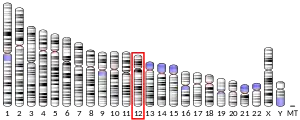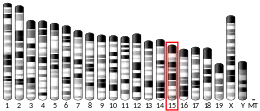Keratin 1 is a Type II intermediate filament (IFs) of the intracytoplasmatic cytoskeleton. Is co-expressed with and binds to Keratin 10, a Type I keratin, to form a coiled coil heterotypic keratin chain. Keratin 1 and Keratin 10 are specifically expressed in the spinous and granular layers of the epidermis.[5] In contrast, basal layer keratinocytes express little to no Keratin 1. Mutations in KRT1, the gene encoding Keratin 1, have been associated with variants of the disease bullous congenital ichthyosiform erythroderma in which the palms and soles of the feet are affected. Mutations in KRT10 have also been associated with bullous congenital ichthyosiform erythroderma; however, in patients with KRT10 mutations the palms and soles are spared. This difference is likely due to Keratin 9, rather than Keratin 10, being the major binding partner of Keratin 1 in acral (palm and sole) keratinocytes.[6]
Type II cytokeratins are clustered in a region of chromosome 12q12-q13.
Interactions
Keratin 1 has been shown to interact with desmoplakin[7] and PRKCE.[8]
See also
References
- 1 2 3 GRCh38: Ensembl release 89: ENSG00000167768 - Ensembl, May 2017
- 1 2 3 GRCm38: Ensembl release 89: ENSMUSG00000046834 - Ensembl, May 2017
- ↑ "Human PubMed Reference:". National Center for Biotechnology Information, U.S. National Library of Medicine.
- ↑ "Mouse PubMed Reference:". National Center for Biotechnology Information, U.S. National Library of Medicine.
- ↑ Freedberg IM (June 1993). "Keratin: a journey of three decades". The Journal of Dermatology. 20 (6): 321–328. doi:10.1111/j.1346-8138.1993.tb01293.x. PMID 7688776. S2CID 41254909.
- ↑ Merleev AA, Le ST, Alexanian C, Toussi A, Xie Y, Marusina AI, et al. (August 2022). "Biogeographic and disease-specific alterations in epidermal lipid composition and single-cell analysis of acral keratinocytes". JCI Insight. 7 (16): e159762. doi:10.1172/jci.insight.159762. PMC 9462509. PMID 35900871.
- ↑ Meng JJ, Bornslaeger EA, Green KJ, Steinert PM, Ip W (August 1997). "Two-hybrid analysis reveals fundamental differences in direct interactions between desmoplakin and cell type-specific intermediate filaments". The Journal of Biological Chemistry. 272 (34): 21495–21503. doi:10.1074/jbc.272.34.21495. PMID 9261168.
- ↑ England K, Ashford D, Kidd D, Rumsby M (June 2002). "PKC epsilon is associated with myosin IIA and actin in fibroblasts". Cellular Signalling. 14 (6): 529–536. doi:10.1016/S0898-6568(01)00277-7. PMID 11897493.
Further reading
- Whittock NV, Ashton GH, Griffiths WA, Eady RA, McGrath JA (August 2001). "New mutations in keratin 1 that cause bullous congenital ichthyosiform erythroderma and keratin 2e that cause ichthyosis bullosa of Siemens". The British Journal of Dermatology. 145 (2): 330–335. doi:10.1046/j.1365-2133.2001.04327.x. PMID 11531804. S2CID 36140204.
- Langbein L, Schweizer J (2005). "Keratins of the human hair follicle". International Review of Cytology. 243: 1–78. doi:10.1016/S0074-7696(05)43001-6. ISBN 9780123646477. PMID 15797458.
- Korge BP, Compton JG, Steinert PM, Mischke D (December 1992). "The two size alleles of human keratin 1 are due to a deletion in the glycine-rich carboxyl-terminal V2 subdomain". The Journal of Investigative Dermatology. 99 (6): 697–702. doi:10.1111/1523-1747.ep12614149. PMID 1281859.
- Compton JG, DiGiovanna JJ, Santucci SK, Kearns KS, Amos CI, Abangan DL, et al. (July 1992). "Linkage of epidermolytic hyperkeratosis to the type II keratin gene cluster on chromosome 12q". Nature Genetics. 1 (4): 301–305. doi:10.1038/ng0792-301. PMID 1284546. S2CID 10795444.
- Rothnagel JA, Dominey AM, Dempsey LD, Longley MA, Greenhalgh DA, Gagne TA, et al. (August 1992). "Mutations in the rod domains of keratins 1 and 10 in epidermolytic hyperkeratosis". Science. 257 (5073): 1128–1130. Bibcode:1992Sci...257.1128R. doi:10.1126/science.257.5073.1128. PMID 1380725. S2CID 30648935.
- Chipev CC, Korge BP, Markova N, Bale SJ, DiGiovanna JJ, Compton JG, Steinert PM (September 1992). "A leucine----proline mutation in the H1 subdomain of keratin 1 causes epidermolytic hyperkeratosis". Cell. 70 (5): 821–828. doi:10.1016/0092-8674(92)90315-4. PMID 1381288. S2CID 19725155.
- Dawson SJ, White LA (May 1992). "Treatment of Haemophilus aphrophilus endocarditis with ciprofloxacin". The Journal of Infection. 24 (3): 317–320. doi:10.1016/S0163-4453(05)80037-4. PMID 1602151.
- Mansbridge JN, Hanawalt PC (March 1988). "Role of transforming growth factor beta in the maturation of human epidermal keratinocytes". The Journal of Investigative Dermatology. 90 (3): 336–341. doi:10.1111/1523-1747.ep12456286. PMID 2450142.
- Lessin SR, Huebner K, Isobe M, Croce CM, Steinert PM (December 1988). "Chromosomal mapping of human keratin genes: evidence of non-linkage". The Journal of Investigative Dermatology. 91 (6): 572–578. doi:10.1111/1523-1747.ep12477087. PMID 2461420.
- Popescu NC, Bowden PE, DiPaolo JA (May 1989). "Two type II keratin genes are localized on human chromosome 12". Human Genetics. 82 (2): 109–112. doi:10.1007/BF00284039. PMID 2470667. S2CID 8064919.
- Johnson LD, Idler WW, Zhou XM, Roop DR, Steinert PM (April 1985). "Structure of a gene for the human epidermal 67-kDa keratin". Proceedings of the National Academy of Sciences of the United States of America. 82 (7): 1896–1900. Bibcode:1985PNAS...82.1896J. doi:10.1073/pnas.82.7.1896. PMC 397440. PMID 2580302.
- Steinert PM, Parry DA, Idler WW, Johnson LD, Steven AC, Roop DR (June 1985). "Amino acid sequences of mouse and human epidermal type II keratins of Mr 67,000 provide a systematic basis for the structural and functional diversity of the end domains of keratin intermediate filament subunits". The Journal of Biological Chemistry. 260 (11): 7142–7149. doi:10.1016/S0021-9258(18)88900-1. PMID 2581964.
- Yang JM, Chipev CC, DiGiovanna JJ, Bale SJ, Marekov LN, Steinert PM, Compton JG (January 1994). "Mutations in the H1 and 1A domains in the keratin 1 gene in epidermolytic hyperkeratosis". The Journal of Investigative Dermatology. 102 (1): 17–23. doi:10.1111/1523-1747.ep12371725. PMID 7507151.
- McLean WH, Eady RA, Dopping-Hepenstal PJ, McMillan JR, Leigh IM, Navsaria HA, et al. (January 1994). "Mutations in the rod 1A domain of keratins 1 and 10 in bullous congenital ichthyosiform erythroderma (BCIE)". The Journal of Investigative Dermatology. 102 (1): 24–30. doi:10.1111/1523-1747.ep12371726. PMID 7507152.
- Syder AJ, Yu QC, Paller AS, Giudice G, Pearson R, Fuchs E (April 1994). "Genetic mutations in the K1 and K10 genes of patients with epidermolytic hyperkeratosis. Correlation between location and disease severity". The Journal of Clinical Investigation. 93 (4): 1533–1542. doi:10.1172/JCI117132. PMC 294170. PMID 7512983.
- Kimonis V, DiGiovanna JJ, Yang JM, Doyle SZ, Bale SJ, Compton JG (December 1994). "A mutation in the V1 end domain of keratin 1 in non-epidermolytic palmar-plantar keratoderma". The Journal of Investigative Dermatology. 103 (6): 764–769. doi:10.1111/1523-1747.ep12412771. PMID 7528239.
- Yoon SJ, LeBlanc-Straceski J, Ward D, Krauter K, Kucherlapati R (December 1994). "Organization of the human keratin type II gene cluster at 12q13". Genomics. 24 (3): 502–508. doi:10.1006/geno.1994.1659. PMID 7536183.
- Peehl DM, Wong ST, Stamey TA (1993). "Vitamin A regulates proliferation and differentiation of human prostatic epithelial cells". The Prostate. 23 (1): 69–78. doi:10.1002/pros.2990230107. PMID 7687781. S2CID 1940715.
- Senshu T, Kan S, Ogawa H, Manabe M, Asaga H (August 1996). "Preferential deimination of keratin K1 and filaggrin during the terminal differentiation of human epidermis". Biochemical and Biophysical Research Communications. 225 (3): 712–719. doi:10.1006/bbrc.1996.1240. PMID 8780679.
- Steinert PM, Marekov LN (January 1997). "Direct evidence that involucrin is a major early isopeptide cross-linked component of the keratinocyte cornified cell envelope". The Journal of Biological Chemistry. 272 (3): 2021–2030. doi:10.1074/jbc.272.3.2021. PMID 8999895.




